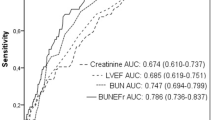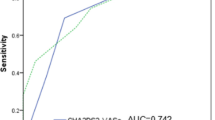Abstract
Background
Contrast-induced nephropathy (CIN) is a serious complication in percutaneous coronary intervention (PCI) patients, which may be related to the contrast dose used during cardiac catheterization.
Methods
We prospectively investigated 277 consecutive consenting patients with acute ST-segment elevation myocardial infarction (STEMI) who were given primary PCI, and we calculated their ratio of volume of contrast media to estimated glomerular filtration rate (V/eGFR). Receiver–operator characteristic methods were used to identify the optimal sensitivity for the observed range of V/eGFR for CIN (i.e., within 48–72 h). The predictive value of V/eGFR for the risk of CIN was assessed using multivariable logistic regression.
Results
Twenty-five (9%) patients developed CIN. The baseline mean and median V/eGFR values were significantly greater among patients with CIN (mean 3.22 ± 1.53, median 2.97, and interquartile range 1.90–4.17) than among those without CIN (mean 1.80 ± 1.00, median 1.52, and interquartile range 1.12–2.21, P < 0.001). The receiver–operator characteristic curve analysis indicated that a V/eGFR ratio of 2.39 was a fair discriminator for CIN (C statistic 0.81). After adjusting for other known predictors of CIN, a V/eGFR ratio ≥ 2.39 remained significantly associated with CIN (odds ratio 4.24, 95% confidence interval 1.23–14.66, P < 0.05).
Conclusion
A V/eGFR ratio ≥ 2.39 was a significant and independent predictor of CIN after primary PCI in patients with STEMI.


Similar content being viewed by others
References
Mehran R, Nikolsky E (2006) Contrast-induced nephropathy: definition, epidemiology, and patients at risk. Kidney Int Suppl 100:11–15
Morcos SK (2005) Prevention of contrast media nephrotoxicity following angiographic procedures. J Vasc Interv Radiol 16:13–23
Mehran R, Aymong ED, Nikolsky E et al (2004) A simple risk score for prediction of contrast-induced nephropathy after percutaneous coronary intervention. J Am Coll Cardiol 44:1393–1399
Bartholomex BA, Harjai KJ, Dukkipati S et al (2004) Impact of nephropathy after percutaneous coronary intervention and a method of risk stratification. Am J Cardiol 93:1515–1519
Cigarroa RG, Lange RA, Williams RH, Hillis LD (1989) Dosing of contrast material to prevent contrast nephropathy in patients with renal disease. Am J Med 86:649–652
Freeman RV, O’Donnell M, Share D et al (2002) Nephropathy requiring dialysis after percutaneous coronary intervention and the critical role of an adjusted contrast dose. Am J Cardiol 90:1068–1073
Giancarlo M (2009) Contrast volume during primary percutaneous coronary intervention and subsequent contrast-induced nephropathy and mortality. Ann Intern Med 150:170–177
Madsen TE, Pearson RR, Muhlestein JB et al (2009) Risk of nephropathy is not increased by the administration of larger volume of contrast during coronary angiography. Crit Pathw Cardiol 8:167–171
US Food and Drug Administration (1995) Toxicokinetics: the assessment of systemic exposure in toxicity studies. Guideline Available at: http://www.fda.gov/cder/guidance/ichs3a.pdf. Accessed 30 July 2006
Bourin M, Jolliet P, Ballereau F (1997) An overview of the clinical pharmacokinetics of X-ray contrast media. Clin Pharmacokinet 32:180–193
Warren K et al (2007) Volume-to-creatinine clearance ratio: a pharmacokinetically based risk factor for prediction of early creatine increase after percutaneous coronary intervention. J Am Coll Cardiol 50:584–590
Marenzi G, Lauri G, Assanelli E et al (2004) Contrast-induced nephropathy in patients undergoing primary angiography for acute myocardial infarction. J Am Coll Cardiol 44:1780–5178
Levey AS, Greene T, Kusek J et al (2000) A simplified equation to predict GFR from serum creatinine. J Am Soc Nephrol 11:155A
Van de Werf F, Ardissino D, Betriu A et al (2003) Management of acute myocardial infarctionin patients presenting with ST-segment elevation. Eur Heart J 24:28–66
Rihal CS, Textor SC, Grill DE et al (2002) Incidence and prognostic importance of acute renal failure after percutaneous coronary intervention. Circulation 105:2259–2264
Morris TW, Katzberg RW, Fischer HW (1978) A comparison of the hemodynamic responses to metrizamide and meglumine/sodium diatrizoate in canine renal angiography. Invest Radiol 13:74–78
Liss P, Nygren A, Olsson U et al (1996) Effects of contrast media and mannitol on renal medullary blood flow and red cell aggregation in the rat kidney. Kidney Int 49:1268–1275
Fujisaki K, Kubo M, Masuda K et al (2003) Infusion of radiocontrast agents induces exaggerated release of urinary endothelin in patients with impaired renal function. Clin Exp Nephrol 7:279–283
Humes HD, Hunt DA, White MD (1987) Direct toxic effect of the radiocontrast agent diatrizoate on renal proximal tubule cells. Am J Physiol 252:246–255
Mueller C, Buerkle G, Buettner HJ et al (2002) Prevention of contrast-associated nephropathy. Arch Intern Med 162:329–336
Pakfetrat M, Nikoo MH, Malekmakan L et al (2009) A comparison of sodium bicarbonate infusion versus normal saline infusion and its combination with oral acetazolamide for prevention of contrast-induced nephropathy: a randomized, double-blind trial. Int Urol Nephrol 41(3):629–634
Kanbay M, Covic A, Coca SG et al (2009) Sodium bicarbonate for the prevention of contrast-induced nephropathy: a meta-analysis of 17 randomized trials. Int Urol Nephrol 41(3):617–627
Sherwin PF, Cambron R, Johnson JA et al (2005) Contrast dose-to-creatinine clearance ratio as a potential indicator of risk for radiocontrast-induced nephropathy: correlation of D/CrCL with area under the contrast concentration time curve using iodixanol. Invest Radiol 40:598–603
Altmann DB, Zwas D, Spatz A et al (1997) Use of the contrast volume to estimated creatinine clearance ratio to predict renal failure after angiography. J Intervent Cardiol 10:113–119
Perrone RD, Madias NE, Levey AS (1992) Serum creatinine as an index of renal function: new insights into old concepts. Clin Chem 38:1933–1953
Goldberg A, Hammerman H, Petcherski S et al (2005) In-hospital and one year mortality of patients who develop worsening renal function following acute ST-elevation myocardial infarction. Am Heart J 150:330–337
Rosenstock JL, Gilles E, Geller AB et al (2010) Impact of heart failure on the incidence of contrast-induced nephropathy in patients with chronic kidney disease. Int Urol Nephrol 42(4):1049–1054
Acknowledgments
The grant support for this study is from Guangdong Cardiovascular Institute, and partial support is from the Guangdong Provincial Cardiovascular Clinical Medicine Research Fund, Guangzhou, China.
Conflict of interest
None to declare.
Author information
Authors and Affiliations
Corresponding author
Rights and permissions
About this article
Cite this article
Liu, Y., Tan, N., Zhou, YL. et al. The contrast medium volume to estimated glomerular filtration rate ratio as a predictor of contrast-induced nephropathy after primary percutaneous coronary intervention. Int Urol Nephrol 44, 221–229 (2012). https://doi.org/10.1007/s11255-011-9910-4
Received:
Accepted:
Published:
Issue Date:
DOI: https://doi.org/10.1007/s11255-011-9910-4




